
Explore the Edible Academy
The Edible Academy supports and enhances NYBG’s ongoing mission to provide children and families access and opportunities to connect with nature. An expanded campus with sustainable infrastructure and a broader range of educational programs and activities double the number of people served from 50,000 to 100,000 annually. In addition the Edible Academy offers new after-school programs, expanded teacher training, cooking demonstrations, distance learning, and special events.
Take a photo tour of the campus below. Click here to view the Site Map.
-
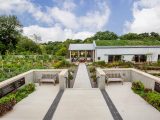
Stavros Niarchos Foundation Entry Plaza
The Niarchos Foundation Entry Plaza provides welcoming access to the Edible Academy and offers a spectacular view of all of the campus components. Seasonal edible plantings flank the entrance gate. -
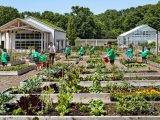
Ruth Rea Howell Vegetable Garden
The Howell Vegetable Garden is a collection of three gardens—Green Thumb Garden, Global Garden, Children’s Gardening Program Garden—with a variety of beds where visitors roll up their sleeves and dig in. The Vegetable Garden provides daily activities and programs to engage children and adults of all ages in planting, tending, and harvesting crops.
Permeable pavement and other materials allow for efficient stormwater management through infiltration and retention, improving quality before it is released into the nearby Bronx River, the only freshwater river in New York City. -
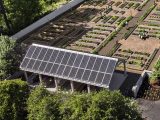
Solar Pavilion
This open-air pavilion is a gathering place for many of the Edible Academy’s garden-based education lessons, with capacity of up to 54 participants.
The roof contains an array of photovoltaic panels to capture solar energy, which is fed into the electrical supply for the entire campus, thereby reducing overall electrical consumption. -
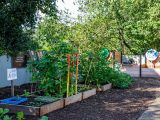
Jean W. Douglas School Garden Demonstration Area
The Douglas School Garden Demonstration Area, designed to inspire teachers to incorporate garden-based education programs on their campuses, includes planting beds, a compost station, and Munchy, the topiary caterpillar. -
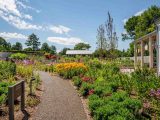
Royce Family Meadow Garden
The Royce Family Meadow Garden features winding paths and a diverse palette of native perennial shrubs and herbaceous plants. It attracts beneficial insects and provides rich opportunities for participants in all Edible Academy programs to observe the important relationships between plants and animals. -
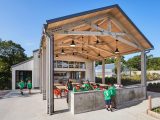
Pauline Gillespie Gossett Overlook Pavilion
The Gossett Overlook Pavilion, situated adjacent to the Classroom Building, provides a dramatic view of the Bronx River waterfall and Thain Family Forest. Many of the Edible Academy’s garden-based education lessons and cooking demonstrations take place in this open-air pavilion, with capacity of up to 72 participants. -
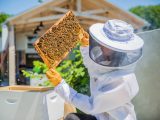
Kate Solomon Family Apiary
The Solomon Family Apiary, viewable from the Overlook Pavilion, is home to two hives with thousands of honeybees that aid essential plant pollination as well as production of delicious honey. -
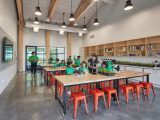
Classroom Building
The Classroom Building, recently certified LEED Gold by the U.S. Green Buildings Council, features the Demonstration Kitchen Classroom, with capacity of up to 35 participants, Palm Family Edible Academy Technology (E.A.T.) Lab, with capacity of up to 35 participants, and a Green Roof with a varied palette of perennials and edible plants.
The green roof reduces stormwater runoff and provides insulation for the 5,300-sq.-ft. building, maximizing water and energy management. Fixtures are resource efficient such as low-flow faucets and LED motion-sensing lights; a retractable garage-style door allows for temperature control. -
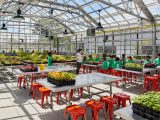
Greenhouse
This teaching greenhouse provides an ideal space and controlled growing conditions for the propagation of thousands of seedlings throughout the year.
A structured “smart” electrical system responds to environmental conditions and adjusts temperature controls as necessary to protect the plants and conserve energy. -
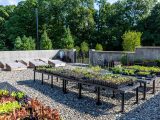
Wamsler Phillips Plant Nursery
The Wamsler Phillips Plant Nursery, an essential part of the Edible Academy’s educational mission, serves as a conditioning area for seedlings propagated in the Greenhouse and destined for the many gardens. -
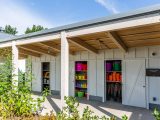
Rappaport Family Toolshed
This charming toolshed houses the Edible Academy’s inventory of garden tools and equipment. -
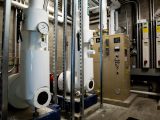
Geothermal Wells
To increase efficiency and reduce carbon emissions in heating and cooling the Classroom Building, a series of eight hydronic wells (465 ft. deep) uses Earth as a sustainable heat source in winter and a heat exchanger in summer by taking advantage of naturally moderate groundwater temperatures. -
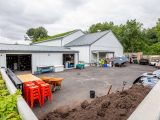
Service Yard
This area is utilized by Edible Academy staff for staging events and as a work space to support programming initiatives.
NYBG’s all-electric, zero-emissions trucks provide delivery services for core operations at the Edible Academy and throughout the Garden. -
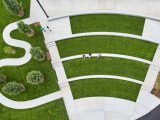
Susan P. and Coley Burke Amphitheater
The Burke Amphitheater, with seating capacity of up to 350, featuring a terraced lawn and stage with the Bronx River and Thain Family Forest as a backdrop, hosts events, cooking demonstrations, and performances.
The amphitheater features a hydrodynamic separator that treats stormwater runoff and improves water quality. -
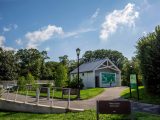
Green Zone with Edible Academy Restrooms
The Green Zone, featuring the Green Materials Recycling Center, is NYBG’s hub for recycling plant-based debris and other organic materials to produce compost and mulch.
The Edible Academy Restrooms (as well as those in the Classroom Building) feature water-less composting toilets, helping to protect the watershed by reducing water consumption as well as alleviating overload to the New York City sanitation system. -

Barnsley Beds
This collection of eight garden beds includes a combination of ornamental arrangements inspired by legendary English garden designer Rosemary Verey and the potager garden style, as well as traditional rows featuring varieties of particular crop groups. A long-term crop rotation plan and companion planting techniques will promote a healthy garden.
Permeable pavement and other materials allow for efficient stormwater management. -
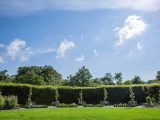
Event Lawn
This semi-circular lawn, framed by the Barnsley Beds, is a wonderful venue for a variety of Edible Academy programming. -
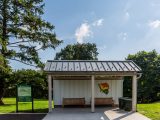
Butterfly Tram Stop
This covered stop provides access to and from the Edible Academy, Garden announcements and orientation, as well as shelter during inclement weather.
NYBG utilizes compressed natural gas (CNG) for its entire tram fleet that services visitors throughout the Garden.